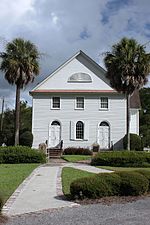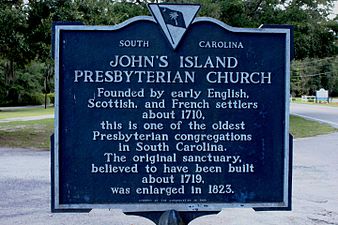
Johns Island is an island in Charleston County, South Carolina, United States, and is the largest island in the state of South Carolina. Johns Island is bordered by the Wadmalaw, Seabrook, Kiawah, Edisto, Folly, and James islands; the Stono and Kiawah rivers separate Johns Island from its border islands. It is the fourth-largest island on the US east coast, surpassed only by Long Island, Mount Desert Island and Martha's Vineyard. Johns Island is 84 square miles (220 km2) in area, with a population of 21,500.

The Holy Trinity Greek Orthodox Church is located at 28 Race St., Charleston, South Carolina. The church was listed on the National Register of Historic Places in 2004. The first Greek Orthodox church in South Carolina was built in 1911 at Fishburne and St. Phillip Sts. Construction of the present church was begun in 1950 and completed in 1953.

St. Mary of the Annunciation Catholic Church is a Catholic church in Charleston, South Carolina, and was the first Catholic parish established in the Carolinas and Georgia. The current building at 93 Hasell Street and is the third structure to house the congregation on this site.
St. Michael's AnglicanChurch is a historic church and the oldest surviving religious structure in Charleston, South Carolina. It is located at Broad and Meeting streets on one of the Four Corners of Law, and represents ecclesiastical law. It was built in the 1750s by order of the South Carolina Assembly. It is listed on the National Register of Historic Places and is a National Historic Landmark.
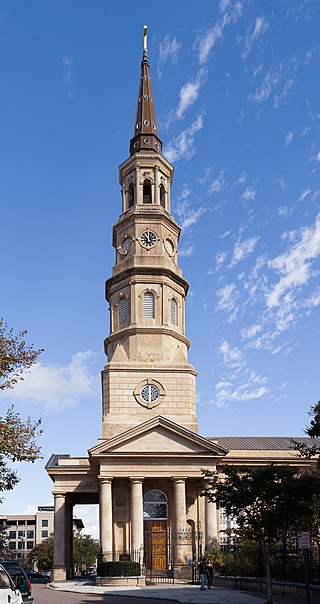
St. Philip's Church is an historic church at 142 Church Street in Charleston, South Carolina. Its National Historic Landmark description states: "Built in 1836, this stuccoed brick church features an imposing tower designed in the Wren-Gibbs tradition. Three Tuscan pedimented porticoes contribute to this design to make a building of the highest quality and sophistication." On November 7, 1973, it was added to the National Register of Historic Places and designated a National Historic Landmark.
William Aiken, or William Aiken, Sr., was the founder and president of the pioneering South Carolina Canal and Rail Road Company.

The South Park Community Church is an historic Carpenter Gothic-style church building located at 600 Hathaway Street in Fairplay, Park County, Colorado. Built in 1874, the church was founded by Presbyterian missionary Sheldon Jackson. Its board and batten siding and lancet windows are typical of Carpenter Gothic churches. Originally the Sheldon Jackson Memorial Chapel, the structure is now the South Park Community (Presbyterian) Church.

Central Baptist Church is a historic Southern Baptist church at 26 Radcliffe Street in Charleston, South Carolina. The Central Baptist Church was completed in 1893 and is considered the first church in Charleston founded and constructed entirely by African-Americans. The structure reflects Carpenter Gothic and Italianate influences and remains in excellent condition. Perhaps the most significant features of the structure are the large folk-art murals portraying biblical scenes including the Crucifixion, the Ascension, and the Resurrection of Christ which date back to 1915. Architect, John Pearson Hutchinson Sr., was hired as a negro carpenter, building contractor, and non-licensed architect. He was also a Deacon of the church. It was built in 1891 and added to the National Register in 1977.

Edisto Island Baptist Church is a historic African-American Baptist church on Edisto Island in Charleston County, South Carolina. Built in 1818, it is a two-story church sheathed in beaded weatherboard with a medium pitched gable roof. An addition doubling its size was completed about 1865, and a two-story pedimented portico was added in 1880.
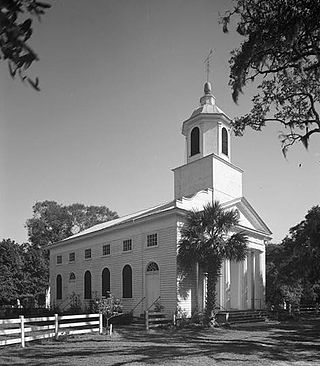
Edisto Island Presbyterian Church is a historic Presbyterian church on Edisto Island, South Carolina.
Presbyterian Manse is a historic wooden building on Edisto Island, South Carolina. This 2+1⁄2-story building was built in 1790 and added to the National Register of Historic Places on May 14, 1971. The building which land was donated by Henry Bowers was constructed for the minister of the church.
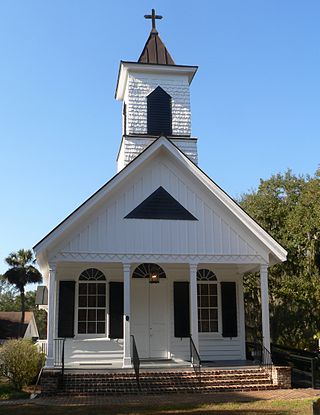
Trinity Church is a church on Edisto Island, South Carolina.

Catholic Presbyterian Church is a historic Presbyterian church in Chester, South Carolina. The church congregation was founded in 1759 and sixty-two men from the church served in the Revolutionary War. Several are buried nearby. The current brick church building, the third located on the same site, was constructed in 1842 and added to the National Register of Historic Places in 1971.

Waxhaw Presbyterian Church Cemetery, also known as Old Waxhaw Cemetery, is a historic Presbyterian church cemetery located near Lancaster, Lancaster County, South Carolina. It was founded in 1757 and is a visual reminder of the pioneer settlement of Waxhaw. It includes noteworthy examples of 18th and 19th century tombstones.

Edward Culliatt Jones was an American architect from Charleston, South Carolina. A number of his works are listed on the U.S. National Register of Historic Places, and two are further designated as U.S. National Historic Landmarks. His works include the following :

John Henry Devereux, also called John Delorey before 1860, was an American architect and builder best known for his designs in Charleston, South Carolina. According to the National Park Service, he was the "most prolific architect of the post-Civil War era" in the Charleston area. His works are listed on the U.S. National Register of Historic Places. His Charleston Post Office and Courthouse has been designated as a U.S. National Historic Landmark.

Prospect Hill is an historic plantation house on Edisto Island, South Carolina. The two-story Federal house is significant for its architecture and ties to the production of sea island cotton. Constructed about 1800 for Ephraim Baynard, it sits on a bluff overlooking the South Edisto River. In 1860, William Grimball Baynard owned Prospect Hill. Baynard was an elder in the Edisto Island Presbyterian Church, a Justice of the Peace, a Justice of the Quorum, and the owner of 220 slaves. When Baynard died in 1861, his son William G. Baynard acquired the house. The house was listed in the National Register of Historic Places on 28 November 1986.

Rockville Historic District is a national historic district located at Rockville, Charleston County, South Carolina. The district encompasses 19 contributing buildings in the town of Rockville. The dwellings reflect Rockville's historic role as a summer resort town. The houses are characterized by spacious porches, raised foundations, and large central hallways designed for summer comfort and relaxation. Located in the district are the Grace Episcopal Church and Wadmalaw Presbyterian Church.
McClellanville Historic District is a national historic district located at McClellanville, Charleston County, South Carolina. The district encompasses 105 contributing buildings in the town of McClellanville. They include residential, commercial, religious and educational building dating between about 1860 to 1935. Architectural styles include: Carpenter Gothic, Queen Anne, and Italianate. Notable buildings include the King Brothers Store, McClellanville Public School, New Wappetaw Presbyterian Church, Bank of McClellanville, McClellanville Methodist Episcopal Church, and a number of dwellings originally built as summer homes by St. James Santee and Georgetown planters.



